Peer-to-peer fundraising guide: How to launch a P2P campaign

Today’s digital tools and communication platforms make it easy for passionate supporters to raise money on behalf of their favorite nonprofit organizations. Thanks to social media and online giving capabilities, leveraging peer-to-peer (P2P) fundraising software has become one of the most effective and engaging ways for organizations to boost donations.
These supporter-led initiatives are powerful ways to amplify your message and boost fundraising revenue. By accessing the power of your supporter community, your nonprofit can reach its fundraising goals and deepen connections with new and existing supporters at the same time.
In this complete guide, we’ll cover everything you need to know about peer-to-peer fundraising so you can launch your own successful P2P campaign in no time.
What is peer-to-peer fundraising?
Peer-to-peer fundraising is a fundraising method in which individual supporters host personalized campaigns to collect donations from friends, family, and colleagues on behalf of your nonprofit.
To host these campaigns, organizations recruit volunteer fundraisers and provide them with fundraising resources. Then, these supporters can raise money individually through a variety of activities, such as participating in events or selling branded merchandise. The goal of peer-to-peer campaigns is to organically expand your organization’s reach to previously untouched networks of supporters while engaging existing ones.
How is peer-to-peer fundraising different from crowdfunding?
Both crowdfunding and peer-to-peer fundraising rely on supporters to spread the word about a campaign and invite their friends to donate online. However, crowdfunding does so by sharing a single campaign page across channels.
Peer-to-peer campaigns, on the other hand, such as the ones made with GiveGab, empower supporters to create personal campaign pages so they can track how much they raise for your nonprofit individually. These campaigns give supporters more agency and allow them to make more personal appeals for donations, ultimately deepening their connections with your cause.
Top peer-to-peer fundraising benefits
Peer-to-peer fundraising is a popular fundraising method for good reason. This type of campaign comes with plenty of impactful benefits, including:
- Access to new audiences. Peer-to-peer fundraising campaigns empower existing supporters to spread the word about your cause among their friends, family, and wider circles of acquaintances. This puts your nonprofit in front of brand-new audiences.
- Personal introductions to your work. The people in your supporters’ vast personal networks already trust their opinions, making it easier to interest new prospective donors in your work.
- Improved supporter relationships. The supporters who volunteer to fundraise on your organization’s behalf will inevitably deepen their connections to your cause, leading to more positive, lasting supporter relationships.
- More efficient fundraising. By leveraging volunteer fundraisers, you’ll reduce your team’s workload and improve the overall efficiency of your campaign.
You can gain all of these benefits easily when you have the right fundraising tools. We’ll dive deeper into how you can simplify campaign management and make it easy for supporters to get involved with peer-to-peer fundraising software later in this guide.
Types of peer-to-peer fundraising campaigns
While peer-to-peer campaigns are highly flexible and can take many different forms, they generally fall into three main categories:
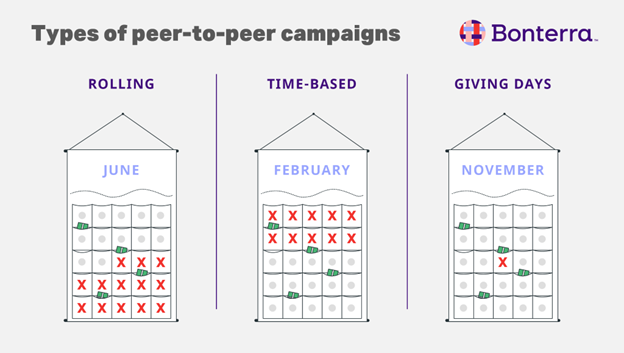
Rolling
Rolling, or ongoing, P2P campaigns don’t run on a specified timeline. In these cases, volunteer fundraisers can launch a personal campaign at any time based on their own schedules. Rolling campaigns don’t have deadlines, either — meaning that volunteers can keep fundraising throughout the year or until they reach their goal.
Time-based
A time-based peer-to-peer campaign operates like any typical fundraising campaign, in which there’s a set launch date and a set end for the fundraiser. For example, you might run a themed time-based campaign from Feb. 1 to Valentine’s Day and invite as many supporters as possible to raise funds during those two weeks.
Giving Days
If you’re looking to add extra excitement to your peer-to-peer fundraiser, you can host a Giving Day that only runs for 24 hours. Invite supporters to focus all of their fundraising energy on one day, whether that’s a holiday like GivingTuesday or another day of your nonprofit’s choosing. These campaigns are fun and fast-paced, but they require plenty of organizing ahead of time.
How to launch a peer-to-peer campaign: 7 steps
Now that you know the basics, let’s explore how you can run a successful peer-to-peer campaign. Follow these key steps to get started:
1. Determine the structure and set goals.
First, choose which type of peer-to-peer fundraising campaign you want to host and nail down the campaign’s timeline.
If you’re hosting a time-based campaign, give potential donors ample time to donate while still creating a sense of urgency. Choose clear start and end dates so donors know how much time they have to support your nonprofit’s purpose. If you host a Giving Day, choose the date carefully and schedule it far enough in advance that your team has enough time to recruit fundraisers and promote the Giving Day effectively.
Then, set measurable, realistic goals for the overall campaign. These goals might look like:
- Raising a total of $10,000 in one month.
- Earning 200 donations from first-time donors.
- Recruiting 50 volunteer fundraisers.
- Adding 500 new contacts to your donor database.
At this time, you should also determine if your campaign will be based around an event, challenge, or theme. Specific, easily visualized themes can help donors get more excited about your campaign and motivate peer fundraisers. Consider creating a theme based on the community you serve, a challenge your community faces, the solution that you and your donors provide, or a special project you have in the works.
2. Choose a peer-to-peer fundraising platform.
Next, invest in a fundraising software solution that has a user-friendly peer-to-peer fundraising tool you can leverage to manage the campaign, create fundraising pages, and track your results.
Investing in a dedicated platform will ensure that your peer fundraisers can easily set up and share their personalized campaign pages, enabling them to earn more donations for your nonprofit. Plus, you’ll give your supporters a centralized place to find information about your peer-to-peer fundraiser and get involved.
For instance, look at how this example from Bonterra GiveGab displays a variety of peer fundraisers and allows website visitors to view individual profiles, see their progress, and donate to their campaigns:
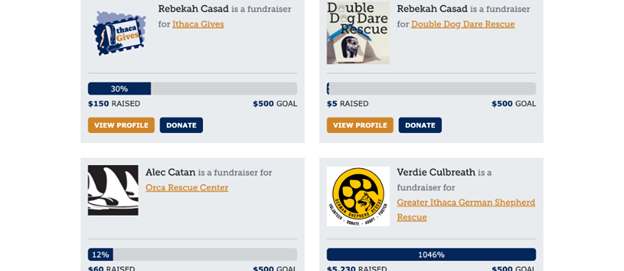
To get the most of peer-to-peer fundraising software, look for a platform with the following essential capabilities:
- Easy-to-create, customizable campaign pages for peer fundraisers
- Robust reporting, tracking, and analytics features
- Social media and email integrations
- Gamification tools like leaderboards and fundraising thermometers
- Ability to host team-based fundraisers
Additionally, ensure that your peer-to-peer fundraising tool integrates with your donor management system so you can easily record information about the new donors you earn during the campaign.
3. Design your peer-to-peer fundraising campaign page.
Once you have a peer-to-peer fundraising platform at your disposal, it’s time to design your campaign pages. These pages should have plenty of room for personalization, but they should also be consistent enough to make donating easy and inspire new supporters to learn more about your nonprofit.
Before you recruit volunteer fundraisers and give them the chance to add personal touches to their pages, design a base campaign page with the following elements:
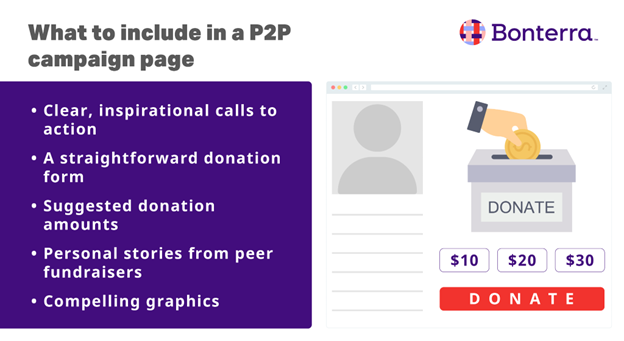
- Clear, inspirational calls to action: Use active, compelling language (like “Donate Now”) to capture new donors’ attention when they land on the page.
- A straightforward donation form: Present prospective donors with a large donation button and a concise, intuitive donation form that’s easy to fill out.
- Suggested donation amounts: Suggested amounts paired with tangible impacts will engage donors, help them understand where funds go, and motivate them to make a larger gift.
- Personal stories: Encourage fundraisers to tell their stories and share their reasons for supporting your organization to help visitors emotionally connect with your cause.
- Compelling graphics: Include branded elements such as your logo and brand colors, then ask your peer fundraisers to add photos to personalize the page.
With these key elements covered, the rest is up to your peer fundraisers. They can personalize their pages with images, stories, and more to make it clear why they’re fundraising for your cause.
4. Market the fundraiser and recruit volunteers.
To recruit supporters to serve as peer fundraisers for your campaign, start by reaching out directly to those who are most passionate about your purpose. Send emails to supporters with a long history with your nonprofit, regular volunteers, recurring donors, and those who frequently share your social media posts.
For a wider reach, you can also post a general call for volunteer fundraisers on social media and your website. Emphasize supporters’ ability to make a larger impact on your organization’s purpose, and provide a sign-up link along with the basic information they need to participate.
5. Provide resources and support for fundraisers.
While it’s important to allow fundraising partners to tell their own stories and fundraise in ways that connect with their networks, providing structured guidelines and resources is crucial for helping them achieve their goals.
Empower your peer fundraisers by equipping them with everything they need to successfully spread the word about your nonprofit’s cause and ask for donations. An ideal peer-to-peer toolbox should include:
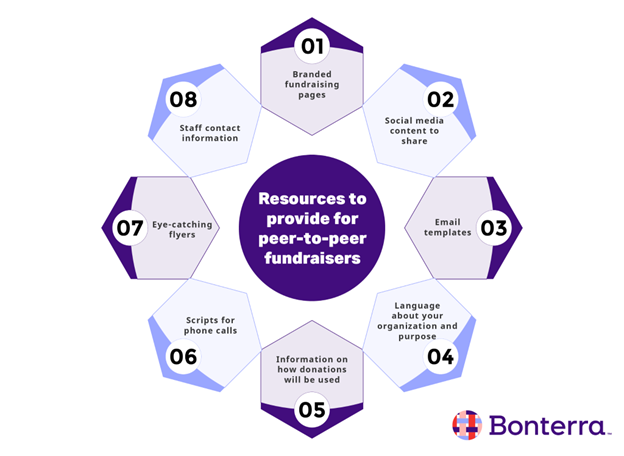
- Branded fundraising pages
- Social media images, videos, and posts to share
- Email templates with pre-written donation appeals
- Consistent language about your organization and purpose
- Information on how donations will be used
- Scripts for phone calls and in-person donation appeals
- Eye-catching flyers peer fundraisers can hand out
- Contact information for a staff member they can go to for help
Your fundraisers may have individual campaign pages, but their work should still be cohesive with the entire peer-to-peer campaign. Providing this toolkit will maximize convenience and consistency in their efforts. A peer-to-peer fundraising platform can supply many of these communication tools, so take advantage of any additional resources your platform provides.
6. Celebrate with your peer fundraisers.
Remember to stay in touch with your peer fundraisers throughout the campaign. Frequent updates and check-ins will give them the confidence and encouragement needed to stay engaged in their fundraising efforts.
Additionally, show appreciation to your peer fundraisers for their contributions. They’ve demonstrated significant devotion to your cause by dedicating their time and energy toward raising money on your nonprofit’s behalf. Consider celebrating your peer fundraisers’ support by:
- Spotlighting them in your marketing communications.
- Regularly sharing your gratitude for their above-and-beyond support.
- Sending them small gifts like branded stickers or water bottles.
- Asking for their feedback at the end of the fundraiser.
- Inviting them to a celebratory in-person or virtual event after the fundraiser.
A peer-to-peer fundraiser is a group effort, so don’t forget to celebrate as a group. Showing your genuine gratitude for their actions will help you retain their support in the future and give them a positive impression of your nonprofit.
7. Cultivate new donors.
Thanks to your peer-to-peer campaign, you’ll have new donors eager to learn more about your nonprofit’s history, impact story, and purpose once the campaign ends. Consider engaging them by sending a welcome kit alongside a note thanking them for their support. No matter what methods you use, be sure to communicate the impact of their gift and invite them to stay in touch with your nonprofit to learn more.
Peer-to-peer fundraising examples
Nonprofits can adapt almost any idea into a peer-to-peer fundraiser. To help you brainstorm the perfect approach for your campaign, here are some popular peer-to-peer fundraising examples to get inspired by:
5Ks and walk-a-thons
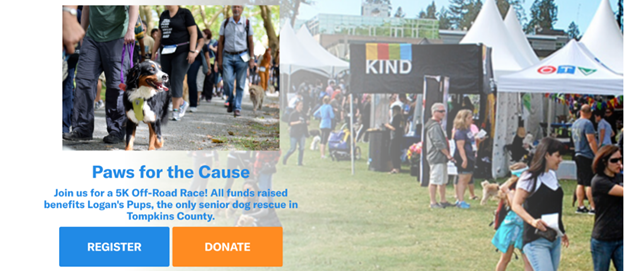
Walk and run events like the Paws for the Cause 5K pictured above make for popular and exciting peer-to-peer campaigns. At these events, volunteer fundraisers register to participate in the race, then they collect pledges and donations in the weeks leading up to the event. They can earn donations based on how far they walk or run, or they can just ask for donations and invite friends and family to cheer them on at the race.
Team-based campaigns
More than any other fundraising method, peer-to-peer fundraising thrives on the relationships between your supporters and their friends, families, and coworkers. This is why peer-to-peer fundraising teams can be your nonprofit’s secret weapon.
Team-based campaigns allow peer-to-peer fundraising volunteers to get together and raise money for your cause as a unit. They work so well because they:
- Tap into existing communities and amplify connections between your supporters.
- Provide a support system for people to cheer one another on throughout your campaign.
- Help members create a positive experience for one another, increasing the chances that they will participate in future campaigns as a unit.
Give your teams the power to launch their own campaigns, share their team fundraising pages with newcomers, and customize their peer-to-peer fundraising experience.
Virtual challenges
Online challenges can inspire plenty of support from both volunteer fundraisers and their networks. To host a peer-to-peer fundraising challenge, choose a task for participants to complete, such as reading a certain number of books or working out for so many hours throughout the month. Let them set their own goals, and encourage them to have fun while raising money for a good cause.
Strategies for successful peer-to-peer fundraising campaigns
To achieve success with any idea, your nonprofit will need the right peer-to-peer fundraising strategy. Let’s explore a few essential best practices for peer-to-peer campaigns.
Host a peer-to-peer fundraising event.
Peer-to-peer fundraisers and events often go hand-in-hand. Your fundraising volunteers can earn donations and have fun with their friends and family when you invite them to an engaging event.
When hosting a peer-to-peer fundraising event, make sure to:
- Choose an event with a broad community interest, like a 5K run or a charity concert.
- Survey your community before choosing your event to see what activities will excite them.
- Follow up with attendees after the event to thank them and encourage them to become long-term supporters.
Consider using an event as either a kick-off or wrap-up party for your P2P campaign. A kick-off event can get fundraisers excited about the upcoming campaign, while wrap-up parties encourage fundraisers to invite potential donors in a last-minute push to achieve their goals. You can also charge admission at these events to earn even more donations.
Keep your supporters connected.
Peer-to-peer fundraising campaigns thrive on social media platforms. Since this fundraising method depends on supporters sharing their fundraising pages across their personal networks, there’s no better place to do so than on social sites like Facebook and Instagram.
Provide resources for your peer fundraisers to connect with others on social media. Set up a Facebook group for fundraisers and create plenty of social media post templates they can use to spread the word about their campaigns.
Additionally, make sure to prioritize the mobile giving experience by optimizing your campaign pages for mobile. Almost every potential donor who hears about your campaign on social media will access your site from their phones, and your fundraising pages must be mobile-accessible for them to follow through with donating.
Make use of P2P fundraising gamification.
To keep your campaign going strong, you’ll need strategies that will keep your peer fundraisers engaged. When your campaign is fun for everyone involved, they’re more likely to make their strongest effort and remain supporters long-term.
For your next peer-to-peer fundraising campaign, try using gamification strategies like:
- Adding real-time fundraising thermometers to your fundraising pages.
- Fostering good-natured competition between P2P fundraising teams.
- Displaying a leaderboard of the top individual fundraisers or teams at your P2P event.
- Awarding prizes to exceptional volunteer fundraisers or high-impact donors.
The right peer-to-peer fundraising software will make it easy to implement these strategies and engage volunteers in gamification. For instance, take a look at how Bonterra Giving Days automatically creates leaderboards highlighting the top peer-to-peer fundraisers to inspire friendly competition:
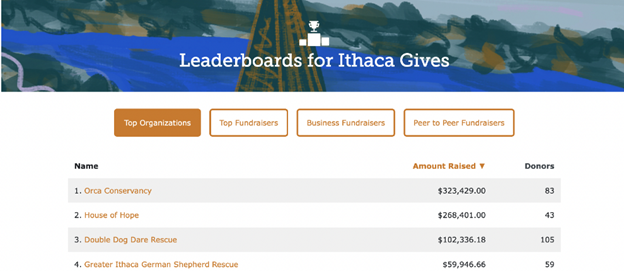
Using a peer-to-peer fundraising platform
An effective peer-to-peer fundraiser requires an equally effective peer-to-peer fundraising software—one that can easily process donations and be widely shared.
In addition to offering customizable fundraising pages for your supporters, your peer-to-peer software solution should equip you with a centralized dashboard where you can keep track of the overall campaign and communicate with your fundraising partners. It should include gamification tools, secure payment processing, and helpful customer support resources you can turn to for help.
As you research your options for robust peer-to-peer fundraising software, make sure to consider:
- Your organization’s budget.
- The platform’s scalability.
- Any training your team will need to use the software.
- Available customer support.
- Integrations with other fundraising tools.
When you find a solution that may be right for you, request a demo and pricing to get the full picture of the platform’s functionality before you commit. The best peer-to-peer fundraising platform will power your entire peer-to-peer fundraising campaign, so make sure it can do so effectively.
Launch your peer-to-peer campaign with Bonterra!
Now that you know the basics, you’re ready to dive into the planning process for your next peer-to-peer fundraising campaign. By using this guide as a resource and investing in the best technology to support your campaign, your nonprofit can set itself up for even greater fundraising success moving forward.
Bonterra Giving Days has all the peer-to-peer functionality you need to succeed.
Work with Bonterra



